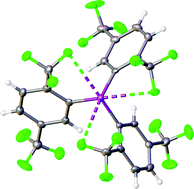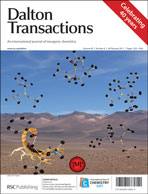Some new phosphorus(III) derivatives Ar2PX (X = Br, Cl, F or H), ArPX2 (X = Br or Cl), Ar3P and ArtBuPCl, with the 2,5-bis(trifluoromethyl)phenyl (Ar) substituent on phosphorus, have been prepared, and characterised by 31P and 19F NMR solution-state spectroscopy. The complexing ability of Ar2PX, Ar3P and ArtBuPCl towards the dimeric platinum(II) complexes [PtY(μ-Y)(PEt3)]2 (Y = Cl or Br, the latter for X = Br only) has also been investigated. Single-crystal X-ray diffraction studies at low temperature have been carried out for Ar3P, Ar2PCl and the hydrolysis or oxidation products Ar2P(H)OH and Ar2P(O)OH. The structures of Ar3P and Ar2PCl are particularly interesting as in each compound the geometry around P is approximately octahedral. In Ar3P there are three short contacts to fluorine as well as the three bonded C atoms for both of the independent molecules in the unit cell. For Ar2PCl there are two short P–F contacts, and the octahedron is completed by a weak P–P interaction to a neighbouring molecule. In both instances the lone pair on the P(III) centre appears to be stereochemically inactive, and does not play a significant role in the structure.

You have access to this article
 Please wait while we load your content...
Something went wrong. Try again?
Please wait while we load your content...
Something went wrong. Try again?


 Please wait while we load your content...
Please wait while we load your content...